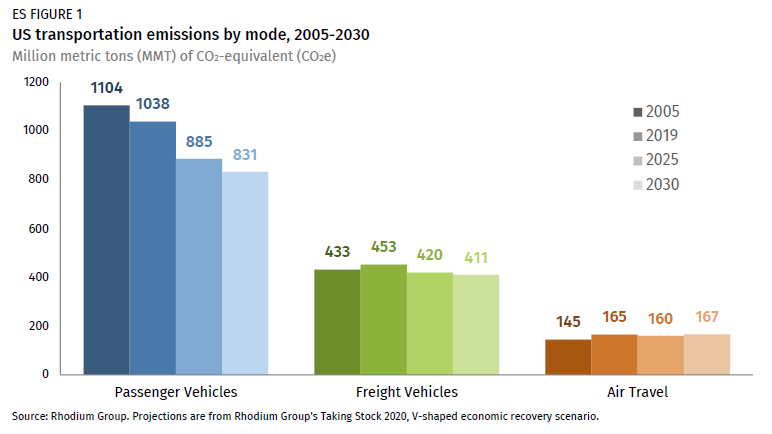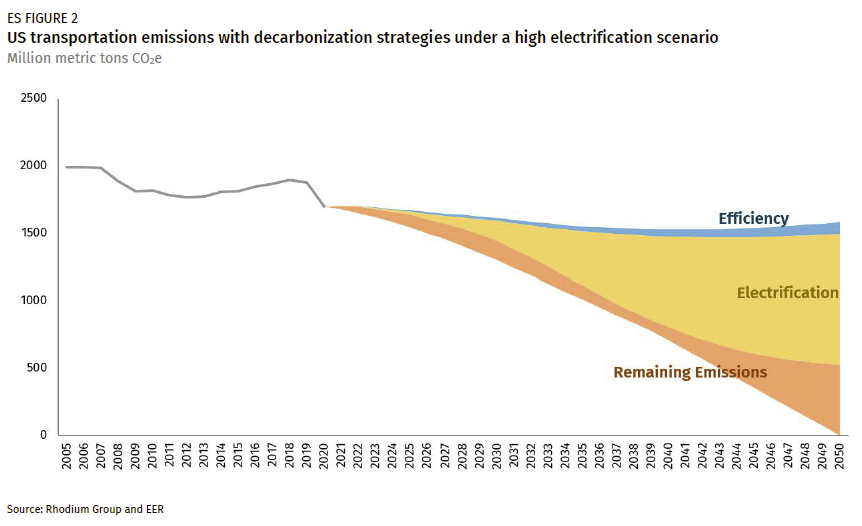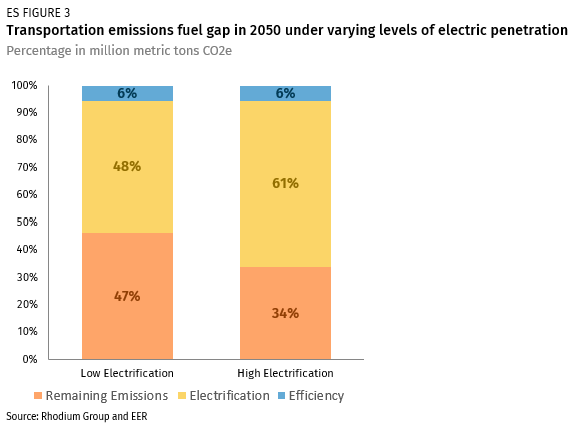Closing the Transportation Emissions Gap with Clean Fuels
While efficiency improvements and vehicle electrification can cut transport emissions by up to two-thirds by 2050, low-GHG liquid fuels are needed to fill the remaining gap.
Federal and state policies adopted over the past two decades have done a great deal to bend the curve of greenhouse gas (GHG) emissions from the US transportation sector. However with 1.6 billion tons of CO2-equivalent projected to come from the transportation sector in 2030, we are still a long way from being on track to net-zero emissions by 2050, or from reducing transportation-related pollutants like NOx, particulate matter, and ozone, which disproportionately impact communities of color and low-income communities.
To achieve economy-wide net-zero emissions, we find that, in the transportation sector, a portfolio of strategies is the lowest cost and most likely to succeed. While efficiency improvements and vehicle electrification can cut transport emissions by up to two-thirds by 2050, low-GHG liquid fuels are needed to fill the remaining gap and achieve net-zero emissions in the transportation sector by mid-century.
Transportation will continue to be one of the largest sources of US emissions
Transportation is the largest source of GHG emissions in the US, accounting for 33% of the economy-wide total in 2019. While transport emissions declined 6% between 2005 and 2019, the majority of reductions have come from the passenger vehicle fleet (light-duty vehicles). Between 2005 and 2019, emissions from freight vehicles rose 5%, and aviation emissions rose by 14%.
Looking forward, under current policy, passenger vehicle emissions are projected to be 20% lower in 2030 than they were in 2019, largely due to increased electrification. However, the same progress is not projected for freight transportation and air travel. Freight emissions are projected to decline by 9%, while aviation emissions are expected to increase by about 1% in 2030 (ES Figure 1).

Electric vehicles alone will not get the US to net-zero by 2050
Under a scenario of modest electrification of light-duty vehicles (LDVs), we project that over 700 million metric tons of emissions will remain in 2050, from fuels that need to be decarbonized or displaced through mobility strategies that reduce vehicle usage (low electrification in ES Figure 3). Under this scenario, electric vehicle sales come in at the lower end of aggressive projections, reaching 35% of LDV sales in 2030 and 77% in 2040. Even with increased LDV electrification (ES Figure 2), where more than half of all LDV sales nationally are electric by 2030 and nearly 90% by 2035, 525 million tons of GHG emissions, 34% of emissions still remain in the transportation sector in 2050. The remaining emission reductions will need to come from fuel decarbonization and mobility solutions. Increasing mobility will reduce vehicle miles traveled but cannot decarbonize the remaining emissions from the transportation sector. Clean fuels will be needed to close the transportation emissions gap.


A portfolio of clean fuels is needed to close the transportation emissions gap
Achieving net-zero emissions in the transportation sector in 2050 will require not just electrification but other strategies as well, including aggressive federal action to deploy a portfolio of clean fuels. We find in our modeling that a combination of advanced biofuels, electrofuels, and carbon-neutral fossil fuels can successfully close the transportation emissions gap and get the sector to net-zero emissions by 2050.
The optimal portfolio of clean fuels will depend on technology cost, feedstock availability and will vary regionally based on local air quality issues, availability of high-quality wind and solar resources and characteristics of the local agricultural economy.
Federal policies to drive clean fuel deployment
Achieving net-zero emissions in 2050 will require aggressive federal action to reduce transportation demand, electrify vehicles, and develop and deploy clean fuels. A portfolio of policies can drive emissions reductions across transportation modes and amplify reductions from policies enacted at the state and local level. The federal government plays a large role in determining the US fuel mix. Research funding, fiscal incentives, market-based policies, and GHG and air quality targets all shape the portfolio of fuel consumed across the country. Rather than relying on existing policies, the federal government can take action to accelerate the deployment and market penetration of the clean fuels needed to achieve net-zero emissions by 2050.
Federal transportation policy should support research and development of clean fuels through funding and investments in transformational fuel technology. Moreover, the federal government can accelerate deployment and development of clean fuels through fiscal incentives aimed at fuel manufacturers and fuel consumers to incentive the production and consumpti0n of clean fuels. Federal procurement policies can also increase market penetration as bulk purchases can increase economies of scale. Ultimately, deep market penetration of clean fuels, required to achieve net-zero emissions by 2050, will require durable price signals and robust federal policies.
This report begins with projections of transportation emissions under current policy, to identify the emission reductions that will be needed to achieve net-zero emissions by 2050. Next, we identify the portfolio of strategies that can achieve net-zero transportation emissions, including a wide range of clean fuels to complement electrification, efficiency, and increased mobility. The report then shifts to the economic and environmental merits of a wide range of clean fuels and the federal policy tools that can drive development and market penetration of clean fuels to achieve net-zero transportation emissions by 2050.